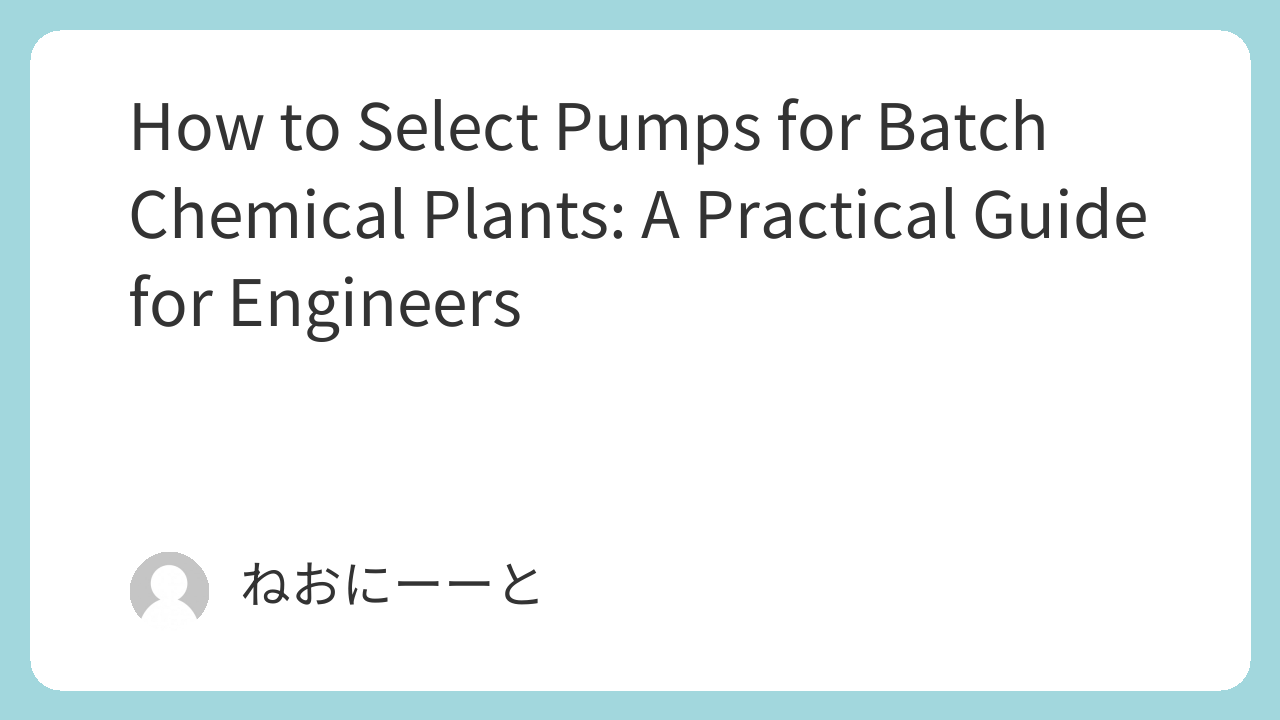When a mechanical engineer in a chemical plant is tasked with equipment selection, the first and most important choice is often the pump. Pumps may seem simple—just devices for moving liquid—but in chemical plants, the liquids’ corrosiveness and process conditions make the selection process far from easy.
This article explains the basic concepts for selecting pumps used in batch-type chemical plants, highlighting key pump types and where each fits best.
Why Mechanical Seals Leak in Pumps — and How to Fix It
Centrifugal Pump Basics: Understanding Structure, Components, and Key Functions
Canned vs. Magnetic‑Drive Pumps: How to Choose the Right Seal‑Less Pump
1. Centrifugal Pumps
In chemical plants, centrifugal pumps are commonly used for utility services—that is, applications involving large volumes of relatively clean, non-corrosive, and low-toxicity liquids.
Even though “centrifugal pump” covers many subtypes, the general rule of thumb for beginners is:
Utility = Centrifugal Pump
However, this doesn’t mean you can only use centrifugal pumps for utilities. Canned or sealless pumps may also work in such cases. Knowing these nuances is what differentiates an experienced engineer from a beginner.
Typical use cases:
- Large flow rates
- Low corrosion potential
- Low health hazard
2. Canned Pumps
Canned pumps are better suited for moderately corrosive liquids or fluids with some degree of toxicity. Their main advantage is the sealless design, eliminating the risk of mechanical seal leakage.
However, since most canned pumps are made of stainless steel, they aren’t ideal for highly corrosive liquids. Personally, I rarely use canned pumps in batch-type plants—fluoropolymer magnet pumps usually perform better.
Still, canned pumps have a wide range of models and can be a great fit in continuous or special-purpose systems.
Typical use cases:
- Moderate corrosion
- Moderate toxicity
3. Fluoropolymer Magnet Pumps
These pumps are used for highly corrosive or toxic liquids. Compared to canned pumps, they further reduce leakage risk thanks to the magnet-driven, sealless structure.
In my experience, magnet pumps and canned pumps cost about the same, so magnet pumps often offer better performance for similar price—a win-win for batch plants.
Their product variety is narrower, but that’s because they’re specialized for one thing: handling corrosive process fluids.
Typical use cases:
- High corrosion
- High toxicity
4. Ceramic Pumps
Ceramic pumps are reserved for extremely corrosive or high-temperature liquids—those beyond the limits of fluoropolymer magnet pumps.
These are used only when “there’s no other option.” Selecting and troubleshooting them requires experimentation and communication between design, maintenance, and production teams to find the right balance.
Typical use cases:
- Extremely corrosive or hot liquids
5. Slurry Pumps
While slurry pumps can technically be classified under centrifugal or canned pumps, batch plants often treat them as a separate category.
That’s because slurry service—especially with corrosive or abrasive particles—poses unique challenges.
Selecting the right slurry pump is often trial and error. Even experienced engineers face difficulties, as modern process fluids have become more complex. Don’t be discouraged by early failures; they’re part of the learning process.
Typical considerations:
- High slurry concentration → Vertical pump
- Avoid seal liquid contamination → Double mechanical seal on centrifugal pump
- High corrosion → Hastelloy or similar high-alloy materials
- Solids handling → Semi-open impeller or better
A combination of “vertical + double-seal + high-alloy” sounds ideal, but real-world operation is never that simple—that’s what makes plant engineering so fascinating.
Conclusion
Pump selection in batch-type chemical plants isn’t just about datasheets—it’s about understanding process characteristics, safety, and material compatibility.
From centrifugal to ceramic pumps, each type has a role depending on corrosion, toxicity, and fluid properties. By recognizing these patterns, engineers can make smarter, safer choices and avoid costly mistakes.

Comments